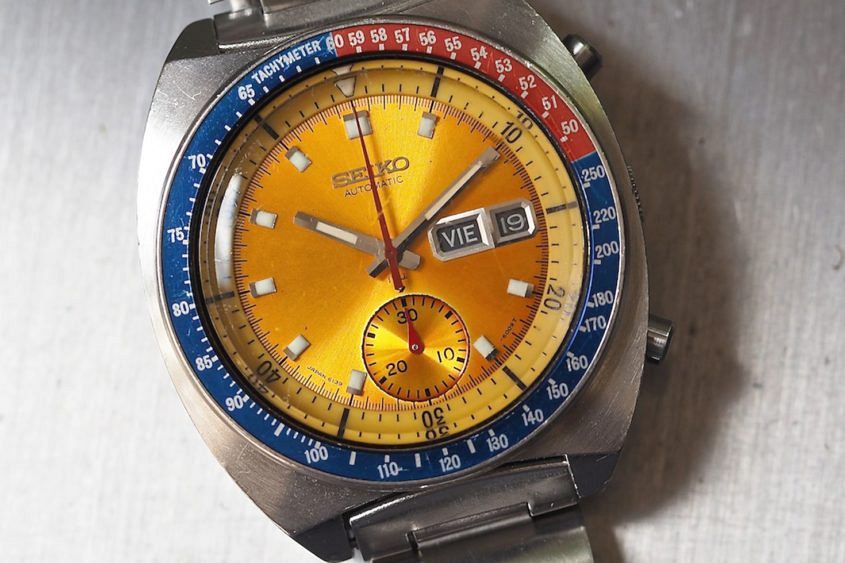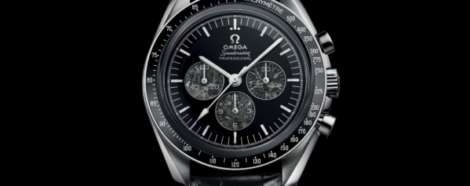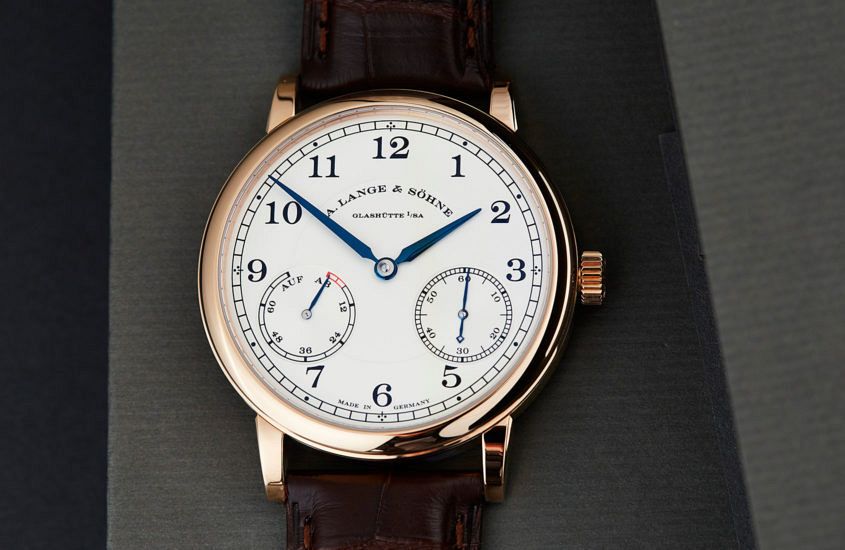 Fifty years ago, the automatic chronograph was born. Depending on which press release, it was the effort of either Zenith, Heuer (et al) or Seiko. The truth lies somewhere in the middle, and the former two brands have been busy celebrating in the traditional Swiss way (limited editions and, presumably, cheese). Seiko, though, has been quiet on the chronograph front, which is, at first glance, odd. Chris Hall, over at QP Magazine, clearly thought so, and put together this story on the matter. He goes into history, corporate politics, R&D and even — occasionally — watches. The real reason why there won’t be a watch to honour the breakthrough of 1969 is that for Seiko, the real breakthrough of 1969 wasn’t the 6139 Speed Timer. I won’t spoil the story here, but if you’re holding out for a celebratory Pogue (who isn’t?), click through to find out why you might be holding on for a good while longer …
Fifty years ago, the automatic chronograph was born. Depending on which press release, it was the effort of either Zenith, Heuer (et al) or Seiko. The truth lies somewhere in the middle, and the former two brands have been busy celebrating in the traditional Swiss way (limited editions and, presumably, cheese). Seiko, though, has been quiet on the chronograph front, which is, at first glance, odd. Chris Hall, over at QP Magazine, clearly thought so, and put together this story on the matter. He goes into history, corporate politics, R&D and even — occasionally — watches. The real reason why there won’t be a watch to honour the breakthrough of 1969 is that for Seiko, the real breakthrough of 1969 wasn’t the 6139 Speed Timer. I won’t spoil the story here, but if you’re holding out for a celebratory Pogue (who isn’t?), click through to find out why you might be holding on for a good while longer …
The post RECOMMENDED READING: Why Seiko won’t be producing a 50th anniversary chronograph appeared first on Time and Tide Watches.


 Fifty years ago, the automatic chronograph was born. Depending on which press release, it was the effort of either Zenith, Heuer (et al) or Seiko. The truth lies somewhere in the middle, and the former two brands have been busy celebrating in the traditional Swiss way (limited editions and, presumably, cheese). Seiko, though, has been quiet on the chronograph front, which is, at first glance, odd. Chris Hall, over at QP Magazine, clearly thought so, and put together this story on the matter. He goes into history, corporate politics, R&D and even — occasionally — watches. The real reason why there won’t be a watch to honour the breakthrough of 1969 is that for Seiko, the real breakthrough of 1969 wasn’t the 6139 Speed Timer. I won’t spoil the story here, but if you’re holding out for a celebratory Pogue (who isn’t?), click through to find out why you might be holding on for a good while longer …
Fifty years ago, the automatic chronograph was born. Depending on which press release, it was the effort of either Zenith, Heuer (et al) or Seiko. The truth lies somewhere in the middle, and the former two brands have been busy celebrating in the traditional Swiss way (limited editions and, presumably, cheese). Seiko, though, has been quiet on the chronograph front, which is, at first glance, odd. Chris Hall, over at QP Magazine, clearly thought so, and put together this story on the matter. He goes into history, corporate politics, R&D and even — occasionally — watches. The real reason why there won’t be a watch to honour the breakthrough of 1969 is that for Seiko, the real breakthrough of 1969 wasn’t the 6139 Speed Timer. I won’t spoil the story here, but if you’re holding out for a celebratory Pogue (who isn’t?), click through to find out why you might be holding on for a good while longer …
 The buying and selling of second-hand watches has traditionally been an unglamorous, possibly even seedy, affair. The traditional image of that side of the industry has been one of tight margins, hard sales talk and the ever-present threat of fakes. Well, in the last few years it’s a part of the business that’s been undergoing something of a quiet revolution. The space is now dominated by the internet, and by large corporate parties like Chrono24 and WatchBox. Richemont has even gotten into the game with their acquisition of Watchfinder. There’s no doubt that this shift is rapidly changing the how of buying a used watch. But you might be wondering why — well, the answer is simple: there’s a lot of money at stake. Head to Blackbird Watch Manual for Elizabeth Doerr’s excellent take on this rapid expansion.
The buying and selling of second-hand watches has traditionally been an unglamorous, possibly even seedy, affair. The traditional image of that side of the industry has been one of tight margins, hard sales talk and the ever-present threat of fakes. Well, in the last few years it’s a part of the business that’s been undergoing something of a quiet revolution. The space is now dominated by the internet, and by large corporate parties like Chrono24 and WatchBox. Richemont has even gotten into the game with their acquisition of Watchfinder. There’s no doubt that this shift is rapidly changing the how of buying a used watch. But you might be wondering why — well, the answer is simple: there’s a lot of money at stake. Head to Blackbird Watch Manual for Elizabeth Doerr’s excellent take on this rapid expansion.  Editor’s note: While Hublot didn’t create the first sapphire-cased watch (that honour goes to Alain Silberstein of all people), the big, bold brand has done an impressive amount of work in a relatively short time to make the ultra-hard, ultra-cool case material mainstream. Don’t believe us? Here’s Sandra’s 2017 timeline of how it went down … First things first, what is sapphire crystal? Essentially, it’s the same stuff used to make a watch ‘glass’ and display casebacks, formed by crystallising aluminium oxide at very high temperatures to create an extremely hard material. Roughly speaking, it mimics what Earth has taken 400 million or so years to do, to form natural sapphire gemstones. For sapphire-cased watches, the middle, bezel and back are milled from solid blocks of the material. Because it’s almost as hard and scratch-resistant as diamond (9 on the Mohs scale, as opposed to 10 for diamond), the task of milling it into the complex shapes required is much more easily said than done. Indeed, sapphire crystal can be cut only by diamond. Harnessing the knowledge it gained from developing a milling technique for Magic Gold (another hugely challenging material), Hublot works with a Swiss specialist as part of…
Editor’s note: While Hublot didn’t create the first sapphire-cased watch (that honour goes to Alain Silberstein of all people), the big, bold brand has done an impressive amount of work in a relatively short time to make the ultra-hard, ultra-cool case material mainstream. Don’t believe us? Here’s Sandra’s 2017 timeline of how it went down … First things first, what is sapphire crystal? Essentially, it’s the same stuff used to make a watch ‘glass’ and display casebacks, formed by crystallising aluminium oxide at very high temperatures to create an extremely hard material. Roughly speaking, it mimics what Earth has taken 400 million or so years to do, to form natural sapphire gemstones. For sapphire-cased watches, the middle, bezel and back are milled from solid blocks of the material. Because it’s almost as hard and scratch-resistant as diamond (9 on the Mohs scale, as opposed to 10 for diamond), the task of milling it into the complex shapes required is much more easily said than done. Indeed, sapphire crystal can be cut only by diamond. Harnessing the knowledge it gained from developing a milling technique for Magic Gold (another hugely challenging material), Hublot works with a Swiss specialist as part of… Editor’s note: The other day I caught up with someone who’d recently picked up an A. Lange & Söhne 1815 Up/Down, and holding it in my hand — by golly gosh, those German guys at ALS know their way around a watch. This piece might not be their most complicated or most hyped, but it’s pretty perfect … Even though there’s no doubt that the darlings of A. Lange & Söhne’s lineup are the more contemporarily styled pieces like the Lange One and the Zeitwerk, there’s still a place for deeply traditional design in the catalogue of Glashütte’s favourite son – and that’s the 1815 collection. Named for the year of founder Ferdinand A. Lange’s birth, the 1815 family of watches takes as its inspiration early marine chronometers. First developed in the 18th century, these ship-bound timepieces were extremely accurate, and a vital tool in navigation. And while the design isn’t what we’d associate with tool watches these days, make no mistake, legibility and reliability were the name of the game. It’s logical that Lange, those masters of function and style, adopt this distinctive look as the trademark for their 1815 collection. With the blued sword-style hands, railroad minute…
Editor’s note: The other day I caught up with someone who’d recently picked up an A. Lange & Söhne 1815 Up/Down, and holding it in my hand — by golly gosh, those German guys at ALS know their way around a watch. This piece might not be their most complicated or most hyped, but it’s pretty perfect … Even though there’s no doubt that the darlings of A. Lange & Söhne’s lineup are the more contemporarily styled pieces like the Lange One and the Zeitwerk, there’s still a place for deeply traditional design in the catalogue of Glashütte’s favourite son – and that’s the 1815 collection. Named for the year of founder Ferdinand A. Lange’s birth, the 1815 family of watches takes as its inspiration early marine chronometers. First developed in the 18th century, these ship-bound timepieces were extremely accurate, and a vital tool in navigation. And while the design isn’t what we’d associate with tool watches these days, make no mistake, legibility and reliability were the name of the game. It’s logical that Lange, those masters of function and style, adopt this distinctive look as the trademark for their 1815 collection. With the blued sword-style hands, railroad minute…